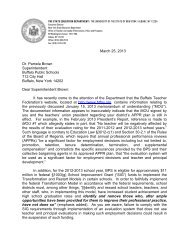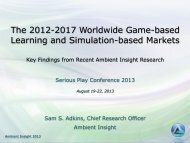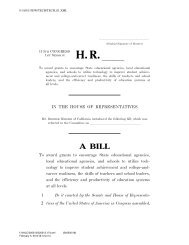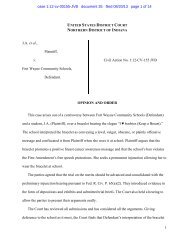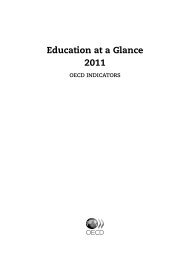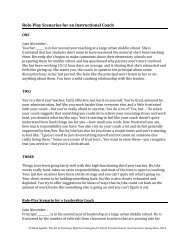Testing More, Teaching Less - American Federation of Teachers
Testing More, Teaching Less - American Federation of Teachers
Testing More, Teaching Less - American Federation of Teachers
- No tags were found...
Create successful ePaper yourself
Turn your PDF publications into a flip-book with our unique Google optimized e-Paper software.
FINDINGSTests in the United States can be categorized intoseveral groups, including:• Large-scale standardized tests, usually summative,mandated by states primarily for accountabilitypurposes;• Interim/benchmarking tests used by districtsto improve performance <strong>of</strong> low-achievingstudents on the state-mandated tests throughtargeted instructional interventions, review andreteaching, regrouping students, identifyingstudents for tutoring and sharing results withstudents; and• A variety <strong>of</strong> locally determined tests, includingsummative, diagnostic and miscellaneoustests, or formative assessment techniques byteachers.Based on a detailed grade-by-grade analysis <strong>of</strong> thedirect costs and the time costs <strong>of</strong> testing in the twoschool districts’ assessment inventories, our studyfound:• Pervasive testing. One <strong>of</strong> the districts in ourstudy had 14 different assessments given toall students at least once a year in at least onegrade. Some assessments are administered forseveral subjects multiple times a year resultingin 34 different test administrations. The otherdistrict’s testing inventory had 12 different assessmentsbut 47 separate administrations overthe course <strong>of</strong> the year.• Test-taking time. Students in one district ingrades 3-10 spent approximately 15 hours ormore per year (about three full school days)taking state-mandated tests, interim/benchmarkingtests and other district academicassessments. Students in the other district ingrades 6-11 devoted up to 55 hours per yearto taking tests (about two full weeks <strong>of</strong> theschool year).• Time for administrative tasks with students.This includes giving directions, passing out testbooklets and answer sheets, reading directionson the computer, etc., before and after eachtesting session. These administrative tasks withstudents took more than five hours annually—one full school day—in one <strong>of</strong> the districts. Inthe other district, administrative tasks with studentsused up more than 10 hours <strong>of</strong> the schoolyear—two full school days—in the most highlytested grades.• Direct budgetary costs. Several national studiesshow that the direct cost <strong>of</strong> purchasing,licensing and scoring state-mandated tests isaround $25 per test-taker, and the annual cost<strong>of</strong> interim/benchmark testing is about $20 pertest-taker. But when considering the cost <strong>of</strong> allthe tests in a school district’s inventory, thedirect budgetary costs <strong>of</strong> the district testingprogram ranged from $50 per test-taker in onedistrict to over $100 per test-taker in the otherfor grades 2-11. The direct budgetary cost <strong>of</strong>state testing represents less than 1 percent <strong>of</strong>K-12 per-pupil education spending. Nationally,education spending averages about $11,000per pupil and reaches $20,000 per pupil in thehighest-spending states.• Logistics and administrative costs. Estimatedat $2 per student per hour <strong>of</strong> testing (up to $80per year for students in several grades in onedistrict), these are costs associated with managingpallets <strong>of</strong> testing boxes; verifying andaffixing data labels to test booklets, which couldinclude three versions <strong>of</strong> the test at each gradelevel; and placing testing materials in securelocations before and after each round <strong>of</strong> testingto prevent cheating. After testing is completed,each school has to collect booklets, pack themand ship them <strong>of</strong>f for scoring.• Test preparation time. The detailed researched-basedrubric narrowly defined “testpreparation” to include giving practice testsand teaching test-taking strategies, but does notcount review, reteaching or tutoring. Studentsin grades 3-8 in one district spent at least 80hours per year (approximately 16 full schooldays) preparing for state-mandated tests, the6 <strong>American</strong> <strong>Federation</strong> <strong>of</strong> <strong>Teachers</strong>



